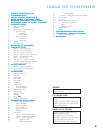
10
REAR-PANEL CONNECTIONS
AM and FM Antenna Terminals: Connect the included AM and
FM antennas to their respective terminals for radio reception.
XM Antenna Jack: Plug in an XM antenna module here. The XM
antenna module is purchased separately, and should specify that it is for
home use with an XM Ready
®
product. You will need to subscribe to the
XM service, which is available separately, and activate the service for
your antenna module. (XM service is not available in Alaska and Hawaii.)
Front, Center and Surround Speaker Outputs: Use two-
conductor speaker wire to connect each set of terminals to the correct
speaker. Remember to observe the correct polarity (positive and negative
connections). Always connect the positive lead to the colored terminal
on the receiver and the red terminal on the speaker. Connect the negative
lead to the black terminal on both the receiver and the speaker. See the
Connections section for more information on connecting your speakers.
Subwoofer Output: If you have a powered subwoofer with a
line-level input, connect it to this jack.
Video 1, Video 2 and DVD Audio/Video Inputs: These jacks may
be used to connect your video-capable source components (e.g., VCR,
DVD player, cable TV box) to the receiver. Use only one type of video con-
nection for each source. See the Connections section for more information
on audio and video connection options for each source component.
Video 1 Audio/Video Outputs: These jacks may be used to
connect your VCR or another recorder.
Composite and S-Video Monitor Outputs: If some of your
sources use composite or S-video connections, connect one or both of
these monitor outputs to the corresponding inputs on your television
or video display to view them.
HDMI Inputs and Output: HDMI (High-Definition Multimedia
Interface) is a newer type of connection for transmitting digital audio and
video signals between devices. Although the AVR 147 is not capable of
processing HDMI signals, if your video display is HDMI-capable, you may
connect up to two HDMI sources here, and then connect the HDMI out-
put to your video display for improved video performance. It is recom-
mended that you disable the HDMI audio function of your video display,
and make a separate digital audio connection from the source device to
one of the AVR’s coaxial or optical digital audio inputs to benefit from
the AVR 147’s multichannel audio processing.
The AVR 147 is Simplay HD-verified for compatibility via the HDMI
connection with other Simplay HD-verified products.
NOTE: The AVR 147 will not convert other types of video to
HDMI, and you will not be able to view the on-screen displays
using the HDMI connection.
CD and Tape Audio Inputs: These jacks may be used to connect
audio-only source components (e.g., CD player, tape deck). Do not
connect a turntable to these jacks unless you are using it with a
phono preamp.
Tape Outputs: These jacks may be used to connect a CDR or
another audio-only recorder.
Coaxial and Optical Digital Audio Inputs: If your source has
a compatible digital audio output, connect it to one of these jacks for
improved audio performance. Use only one type of digital audio connection
for each source.
Coaxial and Optical Digital Audio Outputs: If a source is also
an audio recorder, you may connect a compatible digital audio output to
the recorder’s input for improved recording quality.
The Bridge/DMP Input: Connect the optional Harman Kardon
to this input for use with your iPod (not included). Make
sure the receiver is turned off (in Standby mode) when connecting
The Bridge.
6-Channel Inputs: Connect the multichannel analog audio outputs
of a DVD-Audio, SACD
™
, Blu-ray Disc
™
or HD-DVD
™
player (or any
other external decoder) to these jacks to enjoy these proprietary formats.
Component Video Inputs: If both your video source (e.g., DVD
player or HDTV tuner) and your television or video display have analog
component video (Y/Pb/Pr) capability, then you may connect the
component video outputs of your source to one of the two component
video inputs. Do not make any other video connections to that source.
Component Video Monitor Outputs: If you are using either
of the Component Video Inputs and your television or video display is
component-video-capable, you may connect these jacks to the corre-
sponding inputs on your video display. You will also need to connect the
composite and/or S-video monitor outputs to your video display if some
of your sources use those types of video connections, and to view the
AVR 147’s on-screen displays.
RS-232 Serial Port: This specialized connector may be used with
your personal computer in case Harman Kardon offers a software
upgrade for the receiver at some time in the future.
RS-232 Mode: Leave this switch popped out in the Operate position
unless the AVR 147 is being upgraded.
RS-232 Reset: This switch is only used during a software upgrade.
A standard processor reset is performed by pressing and holding the
front-panel Tone button.
Switched AC Accessory Outlet: You may plug the AC power
cord of one source device into this outlet, and it will turn on whenever
you turn on the receiver. Do not use a source that consumes more than
50 watts of power.
AC Power Cord: After you have made all other connections, plug
the AC power cord into an unswitched outlet.
The
Brid
g
e
TM
AVR147-OM.qxd 2/6/07 3:16 PM Page 10


















